Microservices without DDD is risky business!
2 likes278 views
The document discusses the importance of modularization and service-oriented architecture in software development, emphasizing the need for domain-driven design (DDD) as a mindset for better understanding business domains. Key principles include the autonomy of services, explicit service boundaries, and collaboration between software and domain experts. Additionally, it highlights various subdomains and tactical patterns within DDD to enhance system flexibility and development efficiency.
1 of 35
Download to read offline



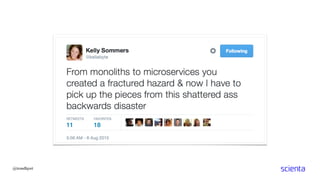
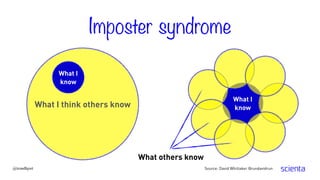
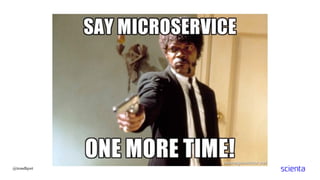
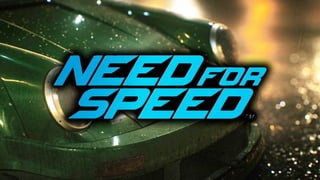
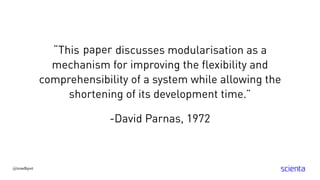
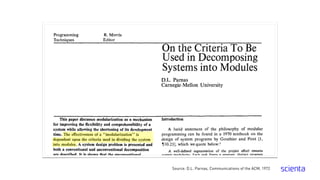

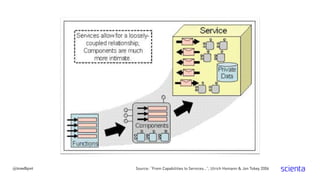

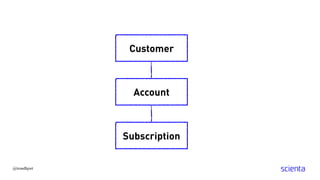
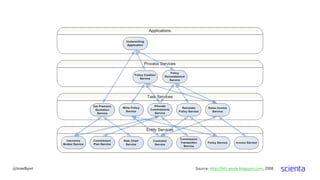
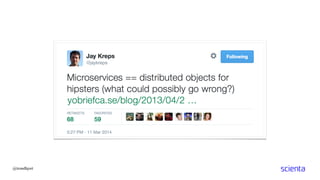
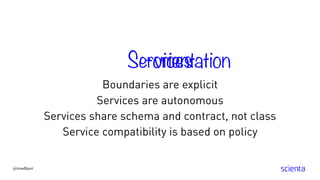
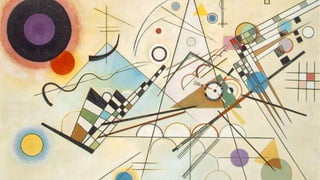
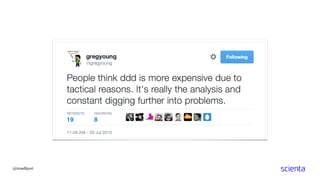
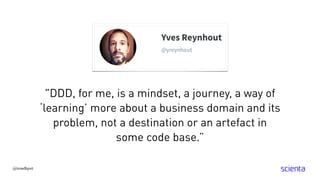
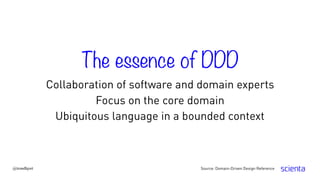
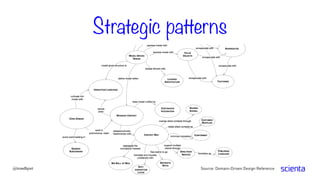
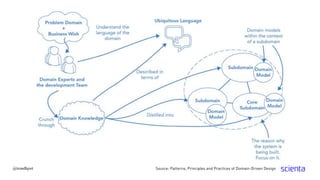
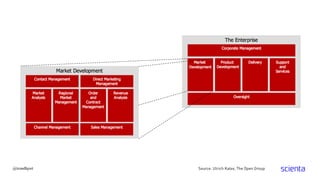
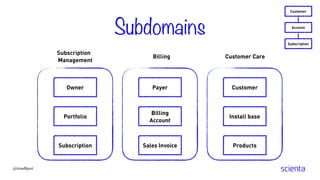
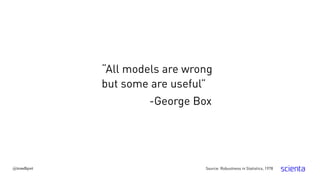
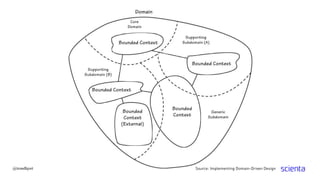
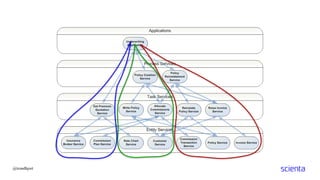

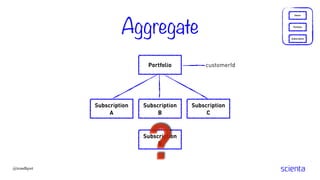
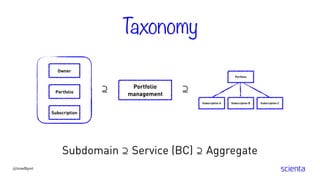
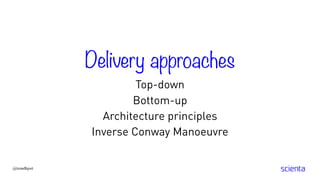
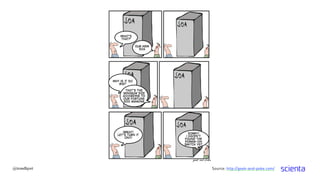
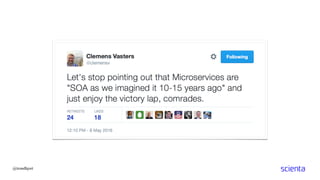

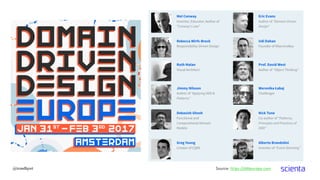
Ad
Recommended
Achieving Data Truthfulness and Privacy Preservation in Data Markets
Achieving Data Truthfulness and Privacy Preservation in Data MarketsJAYAPRAKASH JPINFOTECH
╠²
This paper presents TPDM, a system designed to ensure truthfulness in data markets while preserving the privacy of data contributors. Utilizing an encrypt-then-sign structure, TPDM allows for batch verification and maintains data confidentiality, demonstrating low computational overhead in large-scale applications. The system is evaluated through services like profile matching and data distribution, showcasing its effectiveness on multiple datasets.Microservices without DDD is risky business! REDUX
Microservices without DDD is risky business! REDUXTrond Hjorteland
╠²
The document discusses the risks of implementing microservices without domain-driven design (DDD), emphasizing the importance of modularization to enhance system flexibility and reduce development time. It highlights various patterns, principles, and practices related to DDD and the collaboration between software and domain experts. Additionally, the text references several experts and sources that outline the significance of working with well-defined service boundaries and maintaining autonomy in service operations.Applying Domain-Driven Design to craft Rich Domain Models
Applying Domain-Driven Design to craft Rich Domain ModelsAlexander van Trijffel
╠²
The document discusses domain-driven design (DDD) and its application in crafting rich domain models that encapsulate both data and behavior. It emphasizes the development of an ubiquitous language and the implementation of DDD for medium to large applications to effectively manage business rules and processes. Additionally, the document explores object-oriented principles, the differences between entities and value objects, and tactical DDD patterns for enhancing domain logic.Akar ┼×├╝m┼¤et - Product management is complexity management: End to End approach
Akar ┼×├╝m┼¤et - Product management is complexity management: End to End approachProductTank Odessa
╠²
The document discusses product management and innovation. It introduces the concept of the 5 Ds of product management which are an end-to-end approach consisting of Destination, Discovery, Definition & Design, Development, and Data & Optimization. Each D provides guiding principles and inspiration from thinkers in areas like design thinking, jobs-to-be-done, agile development, and data-driven optimization. The 5 Ds framework aims to connect various concepts and tools to help manage complexity and deliver results through an integrated product.DDD Taiwan Community 2019 01-26-1st-meetup-why ddd matters
DDD Taiwan Community 2019 01-26-1st-meetup-why ddd mattersKim Kao
╠²
The document discusses the importance of Domain-Driven Design (DDD) in solving complex software challenges by emphasizing the understanding of domain and collaboration among stakeholders. It outlines strategies for transitioning to microservices and the principles of effective domain modeling. Key takeaways include prioritizing core domains, fostering ubiquitous language, and focusing on capability-driven design.Introduction to Domain Driven Design
Introduction to Domain Driven DesignChristos Tsakostas
╠²
This document provides an introduction to Domain-Driven Design (DDD), highlighting its motivation, principles, and strategic and tactical designs necessary for developing software that meets complex and evolving business needs. It discusses common problems in software design such as monolithic models and emphasizes the significance of creating multiple models and employing concepts like ubiquitous language to enhance collaboration between domain experts and developers. The wrap-up reinforces the need for continuous redesign and adaptation in strategy and tactics when approaching software architecture.Domain Drive Design: A Very Short Introduction for Business People
Domain Drive Design: A Very Short Introduction for Business PeopleEmre Sevin├¦
╠²
Domain-Driven Design (DDD) is an approach that aims to improve communication between domain experts and software developers by using a shared language reflective of the business domain, thus enabling software systems to be more intuitive and aligned with business needs. It promotes modularity, flexibility, and testability of domain models, enhancing understanding and user experience while facilitating better enterprise architecture. However, DDD is best suited for complex domains as it requires careful implementation and can be resource-intensive but offers significant benefits in aligning technical systems with business objectives.Building digital product masters to prevail in the age of accelerations parts...
Building digital product masters to prevail in the age of accelerations parts...Jeffrey Stewart
╠²
This document discusses the importance of building Digital Product Masters (DPMs) to help organizations adapt and succeed in today's rapidly changing environment. It argues that DPMs can help mitigate risks, reduce costs, and improve revenue. The document is presented in three parts:
Part 1 discusses how the world is accelerating and the new risks organizations face. It suggests that DPMs can help lower costs, mitigate risks, and create stronger customer lock-ins.
Part 2 explains what a DPM is and how it models activities, tools, flows, teams, capabilities, processes, technology, and people. It shows how a DPM can help align these different elements.
Part 3 will provide a case studyD2 domain driven-design
D2 domain driven-designArnaud Bouchez
╠²
The document provides an extensive overview of Domain Driven Design (DDD) principles, focusing on key concepts such as modeling, bounded contexts, and ubiquitous language. It emphasizes the importance of understanding the problem domain, leveraging patterns for clean architecture, and ensuring proper isolation of domain logic from technical concerns. The content discusses various patterns and implementations associated with DDD, including value objects, aggregates, and the architecture layers involved in DDD methodologies.Domain Driven Design
Domain Driven Design Araf Karsh Hamid
╠²
This document discusses domain-driven design (DDD) concepts for transforming a monolithic application to microservices, including:
1. Classifying applications into areas like lift and shift, containerize, refactor, and expose APIs to prioritize high business value, low complexity projects.
2. Focusing on shorter duration projects from specifications to operations.
3. Designing around business capabilities, processes, and forming teams aligned to capabilities rather than technology.
4. Key DDD concepts like ubiquitous language, bounded contexts, and context maps to decompose the domain model into independently deployable microservices.DDD knowledge sharing
DDD knowledge sharingMd. Sadhan Sarker
╠²
Domain-Driven Design (DDD) is an approach that focuses on modeling a complex domain and problem solving. It emphasizes modeling the domain and domain logic over technical details. When building large, mission critical systems, tactics and strategy in DDD address both tactical and strategic design challenges. To get started, one looks at the business processes, breaks the domain into sub-domains, focuses on a sub-domain with domain experts to develop a shared language, and identifies domain events based on commands and queries.Domain Driven Design Quickly
Domain Driven Design QuicklyAliTurgutBOZKURT
╠²
The document is a free online edition of 'Domain-Driven Design Quickly,' aimed at introducing the fundamentals of Domain-Driven Design (DDD) as conceptualized by Eric Evans. It emphasizes the importance of understanding the domain of the software being developed, advocating for a model-driven approach to align software design with real-world complexities. This concise summary serves as a crash course to stimulate interest in DDD, while recommending Evans' original book for more detailed insights.2019-Nov: Domain Driven Design (DDD) and when not to use it
2019-Nov: Domain Driven Design (DDD) and when not to use itMark Windholtz
╠²
The document discusses Domain-Driven Design (DDD) principles and their application in software development, emphasizing the importance of collaboration between business and technical teams. It outlines when to apply DDD, the challenges it addresses, and contrasts it with simpler design approaches. Additionally, it provides a breakdown of strategic and tactical patterns essential for implementing DDD effectively.Taming Complex Domains with Domain Driven Design
Taming Complex Domains with Domain Driven DesignAlberto Brandolini
╠²
This document discusses Domain Driven Design (DDD), an approach for developing software for complex domains. It describes DDD as a set of principles and patterns for modeling domains and building software applications. Key aspects of DDD include focusing on the domain model, continuous learning about the domain with experts, and allowing the model to evolve through refactoring as understanding improves. The document outlines common DDD building blocks like entities, value objects, aggregates and repositories that are used to implement domain models.DevDay2017 ESGI Essential DDD
DevDay2017 ESGI Essential DDDGregory Boissinot
╠²
This document provides an overview of domain-driven design (DDD). Some key points:
- DDD is an approach to software development that focuses on modeling the core domain and problem domain. It aims to create software that is tailored to the needs of its domain.
- When using DDD, developers work closely with domain experts to develop a domain model through knowledge crunching techniques. This domain model serves as a shared language between technical and business teams.
- The domain model is separated from technical concerns. Multiple bounded contexts may be defined to decompose large domains. Code is developed to closely align with the domain model.
- Patterns like entities, aggregates, and repositories are used tactically but DDomain-Driven Design: Part 4 from Delivering the Connected Experience
Domain-Driven Design: Part 4 from Delivering the Connected ExperienceCantina
╠²
Domain Driven Design (DDD) is an approach to software development that models the problem domain using concepts and language from the real world. It recognizes that real businesses have multiple departments that communicate by sending messages, rather than being monolithic. By separating responsibilities into bounded contexts like different departments, complexity is reduced. This also allows the system to scale more easily. DDD uses the "ubiquitous language" of the domain or business to model it, rather than using only technical terms that developers understand. The benefits include gaining a useful model of the domain, refined definitions, domain experts contributing to design, improved user experience, clean boundaries, better enterprise architecture, agile modeling, and new strategic and tactical tools.INVERTIV's End to End Product Management and UX Framework
INVERTIV's End to End Product Management and UX FrameworkAkar Sumset
╠²
The document outlines the 5 D's framework for product management and UX design (PMUX). The 5 D's are: Destination, Discovery, Definition & Design, Development, and Data & Optimization. Each stage addresses key activities like vision, strategy, roadmaps, inspiration, ideation, prototyping, planning, tracking, data collection and optimization. The framework aims to marry product management and UX design using existing methods and tools to build products that deliver results for customers and companies by taking an end-to-end approach.Up to speed in domain driven design
Up to speed in domain driven designRick van der Arend
╠²
This document discusses Domain Driven Design (DDD). It provides an overview of DDD, including that it focuses on removing translation barriers between a domain, development team, and software design. It also describes common building blocks of domain models such as entities, value objects, factories, repositories, and services. Additionally, it discusses refactoring a model to gain deeper insight, including making implicit concepts explicit.Domain Driven Design - garajco Education 2017
Domain Driven Design - garajco Education 2017Can Pekdemir
╠²
Domain Driven Design (DDD) is an approach to software development that focuses on the core domain and business logic. It aims to tackle complexity in business problems. Key aspects of DDD include ubiquitous language, bounded contexts to separate domains, and explicitly modeling entities, value objects, services, aggregates and factories. The goal is for the code model to closely reflect the business domain model. DDD helps with large scale development by dividing systems into autonomous bounded contexts and clarifying relationships between contexts.Schibsted Spain - Day 1 - DDD Course
Schibsted Spain - Day 1 - DDD CourseKevin Mas Ruiz
╠²
The document provides an overview of Domain Driven Design (DDD), emphasizing its focus on incremental changes based on business requirements and effective communication through a ubiquitous language. It discusses various concepts such as bounded contexts, aggregates, entities, and value objects, highlighting the importance of proper modeling, testing, and maintaining data integrity in software development. Additionally, the document stresses the significance of applying Test Driven Development (TDD) principles in DDD to enhance business understanding and code quality.Domain Driven Testing: Know What YouŌĆÖre Doing
Domain Driven Testing: Know What YouŌĆÖre DoingDmitry Vinnik
╠²
The document discusses domain-driven testing (DDT), focusing on its goals, significance, and practical implementation within testing frameworks like the test pyramid. It highlights the importance of context, ubiquitous language, and design principles, addressing common design pitfalls and providing strategies for effective testing. Additionally, it emphasizes user-centric approaches and encourages experimentation to enhance testing methodologies.Code & Cannoli - Domain Driven Design
Code & Cannoli - Domain Driven DesignFrank Levering
╠²
Domain Driven Design (DDD) involves strategic design practices to develop a software model that closely represents the business domain. It focuses on bringing together domain experts and developers to develop a shared ubiquitous language. The domain is divided into subdomains and core domains, with the core domain being the most important to the business. Models are developed for each bounded context, which represents an explicit boundary within a subdomain. Following DDD results in software that makes more sense to both the business and technical aspects of the organization.Customer Driven Engineering is Product Management
Customer Driven Engineering is Product ManagementBen Corn
╠²
The document outlines a framework for product development focused on understanding customer problems, iterating solutions, and incorporating feedback effectively. Emphasizing an agile design process, it highlights the importance of collaboration among team members and defining success through measurable objectives. The end goal is to create products that meet customer needs, drive desired outcomes, and ensure continuous improvement through experimentation.Introducing Domain Driven Design - codemash
Introducing Domain Driven Design - codemashSteven Smith
╠²
The document discusses Domain-Driven Design (DDD), emphasizing its importance in addressing complex domains through clear communication and structured programming practices. It highlights key concepts such as bounded contexts, entities, value objects, aggregates, and domain events while stressing the necessity for a shared language among team members. DDD aims to simplify and enhance the manageability of software solutions by focusing on the problem domain rather than mere technical implementations.Introducing domain driven design - dogfood con 2018
Introducing domain driven design - dogfood con 2018Steven Smith
╠²
The document introduces Domain-Driven Design (DDD), emphasizing its benefits for managing complex domains where clear communication and understanding are vital. It discusses core concepts like bounded contexts, entities, and aggregates, as well as the importance of a ubiquitous language for effective collaboration. Additionally, it highlights the critical role of value objects and domain events, and provides resources for further learning about DDD principles and practices.Domain Driven Design
Domain Driven DesignHannah Farrugia
╠²
- DDD is designed around an onion architecture for loose coupling between domains, applications, and infrastructure
- Event storming helps gather structured information to understand the business domain and requirements
- Entities have unique IDs and are mutable while value objects describe entities and are immutable
- Aggregates group related entities and value objects together, with the root entity accessible from outside
- Invariants, anti-corruption layers, and domain events help model the business logic and handle changesOrg Design for Design Orgs
Org Design for Design OrgsKristin Skinner
╠²
The document explores the evolution and importance of organizational design within design teams, particularly at Adaptive Path and Capital One. It outlines key roles, responsibilities, and strategies for effective design management, emphasizing a customer-centric approach to service design. The content also describes the stages of design organization growth and the integration of design across various functions to enhance user experiences.Design + Development + Devices: The 3 Ds of 3-D Products
Design + Development + Devices: The 3 Ds of 3-D ProductsCourtney Hemphill
╠²
The document discusses the development of products for the ubiquitous web, emphasizing the importance of multi-device interactions and context-aware design. It outlines techniques such as test-driven development (TDD) and experiment-driven design (EDD), which aid in user testing and prototyping for innovative solutions. The content also highlights the necessity of cross-functional teams and agile methodologies in addressing complex problems within product development.Zoho Creator Solution for EI by Elsner Technologies.docx
Zoho Creator Solution for EI by Elsner Technologies.docxElsner Technologies Pvt. Ltd.
╠²
Working with ElsnerŌĆÖs Zoho Creator experts, Educational Initiatives implemented a custom asset management system that: Our Zoho Creator solutions have made real changes across the company, and each team has felt the difference.MOVIE RECOMMENDATION SYSTEM, UDUMULA GOPI REDDY, Y24MC13085.pptx
MOVIE RECOMMENDATION SYSTEM, UDUMULA GOPI REDDY, Y24MC13085.pptxMaharshi Mallela
╠²
Movie recommendation system is a software application or algorithm designed to suggest movies to users based on their preferences, viewing history, or other relevant factors. The primary goal of such a system is to enhance user experience by providing personalized and relevant movie suggestions.More Related Content
Similar to Microservices without DDD is risky business! (20)
D2 domain driven-design
D2 domain driven-designArnaud Bouchez
╠²
The document provides an extensive overview of Domain Driven Design (DDD) principles, focusing on key concepts such as modeling, bounded contexts, and ubiquitous language. It emphasizes the importance of understanding the problem domain, leveraging patterns for clean architecture, and ensuring proper isolation of domain logic from technical concerns. The content discusses various patterns and implementations associated with DDD, including value objects, aggregates, and the architecture layers involved in DDD methodologies.Domain Driven Design
Domain Driven Design Araf Karsh Hamid
╠²
This document discusses domain-driven design (DDD) concepts for transforming a monolithic application to microservices, including:
1. Classifying applications into areas like lift and shift, containerize, refactor, and expose APIs to prioritize high business value, low complexity projects.
2. Focusing on shorter duration projects from specifications to operations.
3. Designing around business capabilities, processes, and forming teams aligned to capabilities rather than technology.
4. Key DDD concepts like ubiquitous language, bounded contexts, and context maps to decompose the domain model into independently deployable microservices.DDD knowledge sharing
DDD knowledge sharingMd. Sadhan Sarker
╠²
Domain-Driven Design (DDD) is an approach that focuses on modeling a complex domain and problem solving. It emphasizes modeling the domain and domain logic over technical details. When building large, mission critical systems, tactics and strategy in DDD address both tactical and strategic design challenges. To get started, one looks at the business processes, breaks the domain into sub-domains, focuses on a sub-domain with domain experts to develop a shared language, and identifies domain events based on commands and queries.Domain Driven Design Quickly
Domain Driven Design QuicklyAliTurgutBOZKURT
╠²
The document is a free online edition of 'Domain-Driven Design Quickly,' aimed at introducing the fundamentals of Domain-Driven Design (DDD) as conceptualized by Eric Evans. It emphasizes the importance of understanding the domain of the software being developed, advocating for a model-driven approach to align software design with real-world complexities. This concise summary serves as a crash course to stimulate interest in DDD, while recommending Evans' original book for more detailed insights.2019-Nov: Domain Driven Design (DDD) and when not to use it
2019-Nov: Domain Driven Design (DDD) and when not to use itMark Windholtz
╠²
The document discusses Domain-Driven Design (DDD) principles and their application in software development, emphasizing the importance of collaboration between business and technical teams. It outlines when to apply DDD, the challenges it addresses, and contrasts it with simpler design approaches. Additionally, it provides a breakdown of strategic and tactical patterns essential for implementing DDD effectively.Taming Complex Domains with Domain Driven Design
Taming Complex Domains with Domain Driven DesignAlberto Brandolini
╠²
This document discusses Domain Driven Design (DDD), an approach for developing software for complex domains. It describes DDD as a set of principles and patterns for modeling domains and building software applications. Key aspects of DDD include focusing on the domain model, continuous learning about the domain with experts, and allowing the model to evolve through refactoring as understanding improves. The document outlines common DDD building blocks like entities, value objects, aggregates and repositories that are used to implement domain models.DevDay2017 ESGI Essential DDD
DevDay2017 ESGI Essential DDDGregory Boissinot
╠²
This document provides an overview of domain-driven design (DDD). Some key points:
- DDD is an approach to software development that focuses on modeling the core domain and problem domain. It aims to create software that is tailored to the needs of its domain.
- When using DDD, developers work closely with domain experts to develop a domain model through knowledge crunching techniques. This domain model serves as a shared language between technical and business teams.
- The domain model is separated from technical concerns. Multiple bounded contexts may be defined to decompose large domains. Code is developed to closely align with the domain model.
- Patterns like entities, aggregates, and repositories are used tactically but DDomain-Driven Design: Part 4 from Delivering the Connected Experience
Domain-Driven Design: Part 4 from Delivering the Connected ExperienceCantina
╠²
Domain Driven Design (DDD) is an approach to software development that models the problem domain using concepts and language from the real world. It recognizes that real businesses have multiple departments that communicate by sending messages, rather than being monolithic. By separating responsibilities into bounded contexts like different departments, complexity is reduced. This also allows the system to scale more easily. DDD uses the "ubiquitous language" of the domain or business to model it, rather than using only technical terms that developers understand. The benefits include gaining a useful model of the domain, refined definitions, domain experts contributing to design, improved user experience, clean boundaries, better enterprise architecture, agile modeling, and new strategic and tactical tools.INVERTIV's End to End Product Management and UX Framework
INVERTIV's End to End Product Management and UX FrameworkAkar Sumset
╠²
The document outlines the 5 D's framework for product management and UX design (PMUX). The 5 D's are: Destination, Discovery, Definition & Design, Development, and Data & Optimization. Each stage addresses key activities like vision, strategy, roadmaps, inspiration, ideation, prototyping, planning, tracking, data collection and optimization. The framework aims to marry product management and UX design using existing methods and tools to build products that deliver results for customers and companies by taking an end-to-end approach.Up to speed in domain driven design
Up to speed in domain driven designRick van der Arend
╠²
This document discusses Domain Driven Design (DDD). It provides an overview of DDD, including that it focuses on removing translation barriers between a domain, development team, and software design. It also describes common building blocks of domain models such as entities, value objects, factories, repositories, and services. Additionally, it discusses refactoring a model to gain deeper insight, including making implicit concepts explicit.Domain Driven Design - garajco Education 2017
Domain Driven Design - garajco Education 2017Can Pekdemir
╠²
Domain Driven Design (DDD) is an approach to software development that focuses on the core domain and business logic. It aims to tackle complexity in business problems. Key aspects of DDD include ubiquitous language, bounded contexts to separate domains, and explicitly modeling entities, value objects, services, aggregates and factories. The goal is for the code model to closely reflect the business domain model. DDD helps with large scale development by dividing systems into autonomous bounded contexts and clarifying relationships between contexts.Schibsted Spain - Day 1 - DDD Course
Schibsted Spain - Day 1 - DDD CourseKevin Mas Ruiz
╠²
The document provides an overview of Domain Driven Design (DDD), emphasizing its focus on incremental changes based on business requirements and effective communication through a ubiquitous language. It discusses various concepts such as bounded contexts, aggregates, entities, and value objects, highlighting the importance of proper modeling, testing, and maintaining data integrity in software development. Additionally, the document stresses the significance of applying Test Driven Development (TDD) principles in DDD to enhance business understanding and code quality.Domain Driven Testing: Know What YouŌĆÖre Doing
Domain Driven Testing: Know What YouŌĆÖre DoingDmitry Vinnik
╠²
The document discusses domain-driven testing (DDT), focusing on its goals, significance, and practical implementation within testing frameworks like the test pyramid. It highlights the importance of context, ubiquitous language, and design principles, addressing common design pitfalls and providing strategies for effective testing. Additionally, it emphasizes user-centric approaches and encourages experimentation to enhance testing methodologies.Code & Cannoli - Domain Driven Design
Code & Cannoli - Domain Driven DesignFrank Levering
╠²
Domain Driven Design (DDD) involves strategic design practices to develop a software model that closely represents the business domain. It focuses on bringing together domain experts and developers to develop a shared ubiquitous language. The domain is divided into subdomains and core domains, with the core domain being the most important to the business. Models are developed for each bounded context, which represents an explicit boundary within a subdomain. Following DDD results in software that makes more sense to both the business and technical aspects of the organization.Customer Driven Engineering is Product Management
Customer Driven Engineering is Product ManagementBen Corn
╠²
The document outlines a framework for product development focused on understanding customer problems, iterating solutions, and incorporating feedback effectively. Emphasizing an agile design process, it highlights the importance of collaboration among team members and defining success through measurable objectives. The end goal is to create products that meet customer needs, drive desired outcomes, and ensure continuous improvement through experimentation.Introducing Domain Driven Design - codemash
Introducing Domain Driven Design - codemashSteven Smith
╠²
The document discusses Domain-Driven Design (DDD), emphasizing its importance in addressing complex domains through clear communication and structured programming practices. It highlights key concepts such as bounded contexts, entities, value objects, aggregates, and domain events while stressing the necessity for a shared language among team members. DDD aims to simplify and enhance the manageability of software solutions by focusing on the problem domain rather than mere technical implementations.Introducing domain driven design - dogfood con 2018
Introducing domain driven design - dogfood con 2018Steven Smith
╠²
The document introduces Domain-Driven Design (DDD), emphasizing its benefits for managing complex domains where clear communication and understanding are vital. It discusses core concepts like bounded contexts, entities, and aggregates, as well as the importance of a ubiquitous language for effective collaboration. Additionally, it highlights the critical role of value objects and domain events, and provides resources for further learning about DDD principles and practices.Domain Driven Design
Domain Driven DesignHannah Farrugia
╠²
- DDD is designed around an onion architecture for loose coupling between domains, applications, and infrastructure
- Event storming helps gather structured information to understand the business domain and requirements
- Entities have unique IDs and are mutable while value objects describe entities and are immutable
- Aggregates group related entities and value objects together, with the root entity accessible from outside
- Invariants, anti-corruption layers, and domain events help model the business logic and handle changesOrg Design for Design Orgs
Org Design for Design OrgsKristin Skinner
╠²
The document explores the evolution and importance of organizational design within design teams, particularly at Adaptive Path and Capital One. It outlines key roles, responsibilities, and strategies for effective design management, emphasizing a customer-centric approach to service design. The content also describes the stages of design organization growth and the integration of design across various functions to enhance user experiences.Design + Development + Devices: The 3 Ds of 3-D Products
Design + Development + Devices: The 3 Ds of 3-D ProductsCourtney Hemphill
╠²
The document discusses the development of products for the ubiquitous web, emphasizing the importance of multi-device interactions and context-aware design. It outlines techniques such as test-driven development (TDD) and experiment-driven design (EDD), which aid in user testing and prototyping for innovative solutions. The content also highlights the necessity of cross-functional teams and agile methodologies in addressing complex problems within product development.Recently uploaded (20)
Zoho Creator Solution for EI by Elsner Technologies.docx
Zoho Creator Solution for EI by Elsner Technologies.docxElsner Technologies Pvt. Ltd.
╠²
Working with ElsnerŌĆÖs Zoho Creator experts, Educational Initiatives implemented a custom asset management system that: Our Zoho Creator solutions have made real changes across the company, and each team has felt the difference.MOVIE RECOMMENDATION SYSTEM, UDUMULA GOPI REDDY, Y24MC13085.pptx
MOVIE RECOMMENDATION SYSTEM, UDUMULA GOPI REDDY, Y24MC13085.pptxMaharshi Mallela
╠²
Movie recommendation system is a software application or algorithm designed to suggest movies to users based on their preferences, viewing history, or other relevant factors. The primary goal of such a system is to enhance user experience by providing personalized and relevant movie suggestions.Threat Modeling a Batch Job Framework - Teri Radichel - AWS re:Inforce 2025
Threat Modeling a Batch Job Framework - Teri Radichel - AWS re:Inforce 20252nd Sight Lab
╠²
This presentation is similar to another presentation I gave earlier in the year at the AWS Community Security Day, except that I had less time to present and incorporated some AI slides into the presentation. In this presentation I explain what batch jobs are, how to use them, and that AI Agents are essentially batch jobs. All the same security controls that apply to batch jobs also apply to AI agents. In addition, we have more concerns with AI agents because AI is based on a statistical model. That means that depending on where and how AI is used we lose some of the reliability that we would get from a traditional batch job. That needs to be taken into consideration when selecting how and when to use AI Agents as batch jobs and whether we should use AI to trigger an Agent. As I mention on one side - I don't want you to predict what my bank statement should look like. I want it to be right! By looking at various data breaches we can determine how those attacks worked and whether the system we are building is susceptible to a similar attack or not. Which Hiring Management Tools Offer the Best ROI?
Which Hiring Management Tools Offer the Best ROI?HireME
╠²
In today's cost-focused world, companies must assess not just how they hire, but which hiring management tools deliver the best value for money. Learn more in PDF!Enable Your Cloud Journey With Microsoft Trusted Partner | IFI Tech
Enable Your Cloud Journey With Microsoft Trusted Partner | IFI TechIFI Techsolutions
╠²
Start your cloud journey with IFI TechŌĆöMicrosoftŌĆÖs trusted partner delivering secure, scalable Azure solutions tailored for your business.
Test Case Design Techniques ŌĆō Practical Examples & Best Practices in Software...
Test Case Design Techniques ŌĆō Practical Examples & Best Practices in Software...Muhammad Fahad Bashir
╠²
This presentation was part of the SQA & PM Bootcamp, where I served as a trainer. It focuses on effective test case design techniques, blending theoretical knowledge with practical application, especially useful for manual testers and QA beginners.
Video Lecture Recording : https://www.facebook.com/share/v/1Z44DiXN5v/
WhatŌĆÖs Covered:
¤¦Š Definition and Purpose of Test Case Design
¤ÜĆ Importance of Structured Test Design
¤¦Ā Test Case Design Techniques Overview:
Ō£ģ Black Box Techniques
Ō£ģ White Box Techniques
Ō£ģ Experience-Based Techniques
¤ōØ Manual Test Case Design in Detail
¤öÉ Real-World Example: Login Page Test Case
¤¦® Black Box Methods Explained with Examples:
Equivalence Partitioning (EP)
Boundary Value Analysis (BVA)
Difference Between EP & BVA
¤ōŖ Decision Table Testing
¤ÆĪ Experience-Based Testing: Error Guessing, Exploratory Testing
¤ōé White Box Techniques (Introductory Overview)
Ō×Ģ Much More to Help You Build Strong Manual Testing Skills
This resource is especially helpful for students, aspiring QA professionals, and junior testers looking to master test design fundamentals with clarity and practical insight.CodeCleaner: Mitigating Data Contamination for LLM Benchmarking
CodeCleaner: Mitigating Data Contamination for LLM Benchmarkingarabelatso
╠²
The pdf-version of "CodeCleaner: Mitigating Data Contamination for LLM Benchmarking" presented in Internetware 2025.IDM Crack with Internet Download Manager 6.42 Build 41 [Latest 2025]
IDM Crack with Internet Download Manager 6.42 Build 41 [Latest 2025]pcprocore
╠²
¤æēCopy link &paste Google new tab > https://pcprocore.com/ ¤æłŌ£ģ
IDM Crack with Internet Download Manager (IDM) is a tool to increase download speeds, resume, and schedule downloads.Comprehensive error recovery and resume capability will restart broken or interrupted downloads due to lost connections, network problems, computer shutdowns, or unexpected power outages. The simple graphic user interface makes IDM user-friendly and easy to use. Internet Download Manager has a smart download logic accelerator with intelligent dynamic file segmentation and safe multipart downloading technology to accelerate your downloads. Unlike other download managers and accelerators, Internet Download Manager segments downloaded files dynamically during the download process and reuses available connections without additional connect and login stages to achieve the best acceleration performance for IDM users.
System Requirements of IDM:
Operating System: Windows XP, NT, 2000, Vista, 7, 8, 8.1, 10 & 11 (32bit and 64bit)
Memory (RAM): 512 MB of RAM required
Hard Disk Space: 25 MB of free space required for full installation
Processor: Intel Pentium 4 Dual Core GHz or higher. Ensure your system meets these requirements for the IDM Crack to function properly.
How to Install and Crack:
Temporarily disable the antivirus until the IDM Crack process
Install ŌĆ£idman642build41.exeŌĆØ
Extract ŌĆ£IDM 6.42.41 Patch.rarŌĆØ (Password is: 123)
Install ŌĆ£IDM 6.42.41 Patch.exeŌĆØ
Done!!! Enjoy!!!CodeCleaner: Mitigating Data Contamination for LLM Benchmarking
CodeCleaner: Mitigating Data Contamination for LLM Benchmarkingarabelatso
╠²
The pdf version of "CodeCleaner: Mitigating Data Contamination for LLM Benchmarking" presented in Internetware 2025.Why Edge Computing Matters in Mobile Application Tech.pdf
Why Edge Computing Matters in Mobile Application Tech.pdfIMG Global Infotech
╠²
This PDF explores the critical role of edge computing in modern mobile application technology. Learn how edge enhances app speed, reduces latency, improves data privacy, and supports real-time performance. Ideal for developers, tech strategists, and mobile innovators looking to stay ahead in the evolving mobile ecosystem.declaration of Variables and constants.pptx
declaration of Variables and constants.pptxmeemee7378
╠²
Rules of declaration of variables and constantsStreamlining CI/CD with FME Flow: A Practical Guide
Streamlining CI/CD with FME Flow: A Practical GuideSafe Software
╠²
Join us as we explore how to deploy a fault-tolerant FME Flow installation using FME FlowŌĆÖs IaC templates alongside Terraform, AWS, and GitHub in a CI/CD workflow. This session will also cover how to leverage FMEŌĆÖs CI/CD capabilities for FME Flow upgrades and FME object migration between different environments, ensuring seamless automation and scalability.Modern Platform Engineering with Choreo - The AI-Native Internal Developer Pl...
Modern Platform Engineering with Choreo - The AI-Native Internal Developer Pl...WSO2
╠²
Building and operating internal platforms has become increasingly complex ŌĆö sprawling toolchains, rising costs, and fragmented developer experiences are slowing teams down. ItŌĆÖs time for a new approach.
This slide deck explores modern platform engineering with Choreo, WSO2ŌĆÖs AI-native Internal Developer Platform as a Service. Discover how you can streamline platform operations, empower your developers, and drive faster innovation ŌĆö all while reducing complexity and cost.
Learn more: https://wso2.com/choreo/platform-engineering/University Campus Navigation for All - Peak of Data & AI
University Campus Navigation for All - Peak of Data & AISafe Software
╠²
Navigating around the 1000 acres of UBC VancouverŌĆÖs campus may look like a walk in a park, but when youŌĆÖre a student in a wheelchair trying to find a powered door to the class youŌĆÖre late for, it is not all that scenic. UBCŌĆÖs GIS team will share the journey from the original 2003 static map application to the current web application built using FME and the ArcGIS JavaScript API. There were two main goals with this new application: 1. Enable the UBC community to easily interact with and navigate the campus by walking, cycling and accessible means (which include mobility constraints such as steep slopes, stairs, and doors that are not powered). 2. Provide high quality geospatial data that is authoritative and updated using FME to reflect existing conditions on campus including road, sidewalk or building closures for construction. We will cover the unique challenges in creating a navigation application which offers features that Google Maps cannot at the scale of a University campus. Door to door navigation, avoiding stairs and steep slopes, navigating to accessible entrances and up to date construction barriers are some of the features we will discuss.Why Every Growing Business Needs a Staff Augmentation Company IN USA.pdf
Why Every Growing Business Needs a Staff Augmentation Company IN USA.pdfmary rojas
╠²
U.S. staff augmentation companies excel at providing IT professionals with expertise in development, cybersecurity, AI, and more. Whether you need to fill a short-term gap or enhance your teamŌĆÖs capabilities long-term, these firms deliver pre-vetted talent tailored to your tech stack and industry. With an understanding of both global technologies and local compliance, U.S.-based IT staff augmentation bridges the gap between talent shortage and project demand efficiently.Top Time Tracking Solutions for Accountants
Top Time Tracking Solutions for Accountantsoliviareed320
╠²
This presentation explores the importance of time tracking for accountants and introduces modern solutions that help streamline billable hours, improve productivity, and eliminate manual tracking errors. Learn how time tracking software tailored for accounting professionals can simplify client billing, ensure compliance, and enhance profitability.
From key challenges in time management to top features to look for in a solution, this presentation offers valuable insights and practical tips for solo accountants, finance teams, and accounting firms looking to optimize their time-tracking workflows.https://www.invoicera.com/blog/invoicing/best-time-tracking-software-for-accountants/
Simplify Insurance Regulations with Compliance Management Software
Simplify Insurance Regulations with Compliance Management SoftwareInsurance Tech Services
╠²
Streamline your compliance processes and stay up-to-date with changing regulations effortlessly. Our Compliance Management Software helps insurers reduce risk, avoid penalties, and maintain full compliance ŌĆö all from a unified platform. Explore More - https://www.damcogroup.com/insurance/compliance-management-softwareDownload Adobe Illustrator Crack free for Windows 2025?
Download Adobe Illustrator Crack free for Windows 2025?grete1122g
╠²
COPY & PASTE LINK ¤æē¤æē¤æē https://click4pc.com/after-verification-click-go-to-download-page/
Adobe Illustrator CC Crack will make your illustration level upgrade by moving toward real modification purpose using adobe pro tools there ..Foundations of Marketo Engage - Programs, Campaigns & Beyond - June 2025
Foundations of Marketo Engage - Programs, Campaigns & Beyond - June 2025BradBedford3
╠²
Join us for an exciting introductory session on, Foundations of Marketo Engage: Programs, Campaigns & Beyond. Ideal for new and early-stage users looking to build confidence and capability in Marketo Engage.
Our speakers for this session will be:
AJ Navarro
Marketing Operations Manager - Sprout Social
Bobby Coppola
Marketing Manager - Blue Yonder
This event will guide you through the essential steps to build strong, scalable Programs, Channels, Tags, Smart Campaigns, and Reporting Basics in Marketo Engage.
Attendees will gain practical knowledge on how to structure and launch marketing initiatives, leverage templates for efficiency, and implement best practices for campaign execution and measurement. You'll leave with actionable insights you can immediately apply to your own Marketo instance to improve organization, automation, and reporting. Marketo Engage.
Learn how to create impactful programs and understand the best practices for seamless campaign management and effective reporting.
DonŌĆÖt miss out on this opportunity to gain hands-on guidance from experienced practitioners and to connect with peers who are also new to the platform. Secure your spot today and start building your path to becoming a Marketo pro!
Please feel free to invite colleagues who you think would also benefit from this session.Test Case Design Techniques ŌĆō Practical Examples & Best Practices in Software...
Test Case Design Techniques ŌĆō Practical Examples & Best Practices in Software...Muhammad Fahad Bashir
╠²
Ad
Microservices without DDD is risky business!
- 1. Making IT your winning asset
- 2. Trond Hjorteland Partner at scienta.no @trondhjort
- 3. Microservices without DDD is risky business!
- 4. @trondhjort
- 5. Imposter syndrome Source: David Whittaker @rundavidrun What I think others know What I know What I know What others know @trondhjort
- 6. @trondhjort
- 8. ŌĆ£This _____ discusses modularisation as a mechanism for improving the flexibility and comprehensibility of a system while allowing the shortening of its development time.ŌĆØ @trondhjort -David Parnas, 1972 paper
- 9. Source: D.L. Parnas, Communications of the ACM, 1972
- 11. Source: ŌĆ£From Capabilities to ServicesŌĆ”ŌĆØ, Ulrich Homann & Jon Tobey 2006@trondhjort
- 15. @trondhjort
- 16. Service-orientation Boundaries are explicit Services are autonomous Services share schema and contract, not class Service compatibility is based on policy s @trondhjort
- 18. @trondhjort
- 19. "DDD, for me, is a mindset, a journey, a way of ŌĆślearningŌĆÖ more about a business domain and its problem, not a destination or an artefact in some code base.ŌĆØ @trondhjort
- 20. Collaboration of software and domain experts Focus on the core domain Ubiquitous language in a bounded context The essence of DDD @trondhjort Source: Domain-Driven Design Reference
- 21. Strategic patterns Source: Domain-Driven Design Reference@trondhjort
- 22. Source: Patterns, Principles and Practices of Domain-Driven Design@trondhjort
- 23. Source: Ulrich Kalex, The Open Group@trondhjort
- 24. Subdomains Customer Account Subscription Billing Customer Care Subscription Management Billing Account Customer Subscription Portfolio Owner Payer Sales Invoice Install base Products @trondhjort
- 25. ŌĆ£All models are wrong but some are usefulŌĆØ -George Box Source: Robustness in Statistics, 1978@trondhjort
- 26. Source: Implementing Domain-Driven Design@trondhjort
- 27. @trondhjort
- 28. Tactical patterns Source: Domain-Driven Design Reference@trondhjort
- 30. Subdomain ŌŖć Service (BC) ŌŖć Aggregate Subscription Portfolio Owner Portfolio management ŌŖć Taxonomy Portfolio Subscription A Subscription B Subscription C ŌŖć @trondhjort
- 31. Delivery approaches Top-down Bottom-up Architecture principles Inverse Conway Manoeuvre @trondhjort
- 33. @trondhjort
